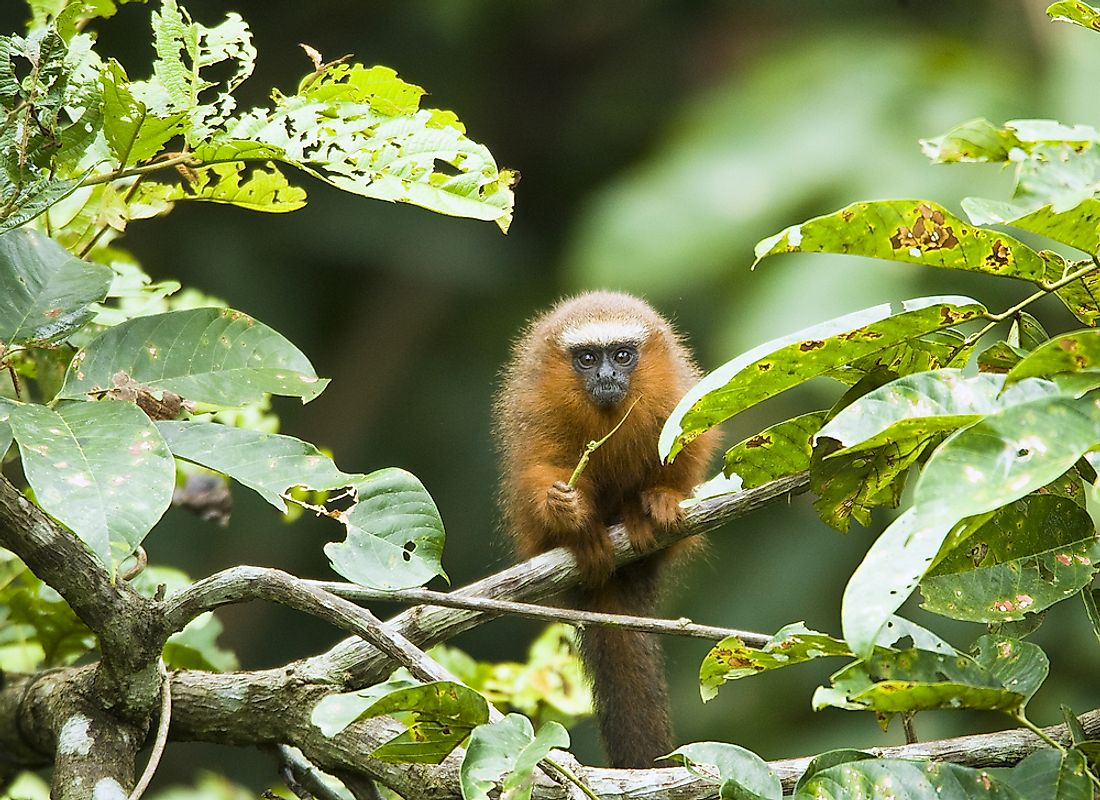Titi Monkey Facts - Animals of South America

Titis are small, rabbit- sized, non-prehensile tailed monkeys of family Callicebinae. They are found in the South American states of Brazil, Peru, Ecuador, Bolivia, Colombia, and Paraguay. They mostly inhabit humid tropical and sub-tropical forests since their diet primarily consists of vegetation.
4. Physical Description
Titi monkeys mostly have reddish, brownish or blackish fur, although the shades may differ depending on each species. The fur is long, thick and soft, with a somewhat shaggy appearance, and having lighter shades on the undersides.
They have long hind limbs. They have relatively short canines adaptive for feeding on vegetation and fruits. The tail is furry and non-prehensile. The female tail can range from 36-64cm in length while that of males ranges from 39-50cm.
Male titi monkeys range in weight from 850g-1200g (1.9-2.6lb), while females range from 700-1020g (1.5-2.2lb). Female body length ranges from 29-42cm, while that of males from 30-45cm.
They move by walking, clambering, and leaping (quadrupedal). They are rarely seen on the ground as they inhabit trees in search for vegetation. When on the ground, they move quite fast.
3. Diet
Their diet consists mainly of fruits (frugivores) although they also feed on leaves, insects, birds’ eggs and small vertebrates. They feed on mostly unripe fruits from small trees. They eat insects such as cocoons, butterflies, moths, spiders, and ants. A large portion of their diet is also leaves, especially young leaves, and leaf buds, which are a source of protein.
They basically do not need to drink water as they derive it from their food. The fruits and leaves have high water content which is sufficient to quench their thirst. Some species, however, are known to drink water from the rivers and streams.
2. Habitat and Range
Titi monkeys inhabit the South American states of Colombia, Bolivia, Brazil, Ecuador, Paraguay, and Peru. Different species are native to these states depending on factors such as climate, vegetation cover, and altitude.
In Brazil, for example, the species found are C.baptista, C. bernhardi, C. cinerascenes, and C. moloch. Species found in Bolivia are C.donacophilus and C. aureipalatti which inhabit the north-western parts of Bolivia. Other species found in Bolivia as well as Brazil and Peru are the C.brunneu, C. oenathe, and C.cupreus. C.discolor is found in Colombia, Ecuador, Peru and Brazil.
C. ornatus is only found in eastern Colombia while C. pallescens is the only species of titi monkey found in Paraguay.
Titi monkeys prefer inhabiting areas with dense vegetation such as forest edges, swamps, rain forests, riverbanks, thickets, etc. They like forests and freefall edges as well as secondary growth and patches, found in the middle of savannahs and near rivers. They move around their habitats to search for fruits since most fruits consumed by them are seasonal.
Several species have distinct habitat preferences. For example, C.donacophilus inhabits open grasslands and savannahs while C. cinerascens prefers woodlands and dense forests.
1. Behavior
Titis live in camps consisting of at least two members up to a maximum of seven, with the male having some degree of leadership in these groups. They are monogamous in nature having only one mating partner for life. The male cares for the infants, protects it and only gives it to the mother for nursing.
These monkeys are mainly active during the day until sunset when they retire. During the warm season, there is plenty of fruit which makes them rise early to feed and in the colder season, they tend to sleep more since fruits are hard to find during such time.
Their sleeping places are on branches found roughly 15 meters off the ground. Members sleep close to one another and generally entwine their tails and huddle together.
They have small home ranges; therefore, they do not exhibit considerable curiosity. They are hesitant to approach new situations. Since they are territorial, they utilize a variety of vocalizations to define, protect their boundaries, and reinforce their territory.
Titi monkeys can co-exist peacefully with other primates such as squirrel monkeys, owl monkeys, tamarins among others. Larger species of primates would compete with titis for food especially the larger fruit trees, and the titis would be chased away completely.
Their communication is characterized by high and low pitched squeaks, trills, chirps, and grunts. When faced with threats and violence, they communicate with the high-pitched sounds, while the lower sounds are often used in communication amongst themselves and with other social groups in the habitat. They moan during copulation, affection, and greeting.
Titis also communicate physically by grooming one another and entwining their tails during sleep. Male and female mates groom and entwine with each other rather than with other members of their group. The males are very protective and caring to their mates and would often groom them and their infants too.
Raptors such as eagles and owls prey on titi monkeys. Other predators include jaguars and snakes. Infant titis are more vulnerable to predators although the males always offer intense protection to them. To protect themselves from such predators, titi monkeys often hide in the dense vegetation, intertwined figs, and branches where the predators would have difficulty in finding them.











